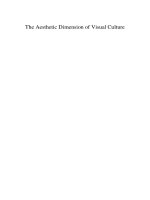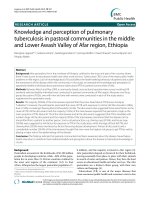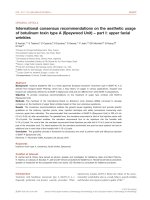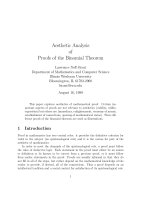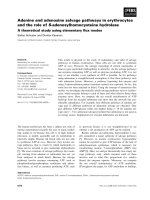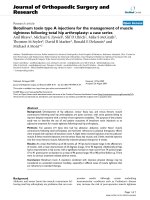International consensus recommendations on the aesthetic usage of botulinum toxin type A (Speywood Unit) – part II: wrinkles on the middle and lower face, neck and chest pdf
Bạn đang xem bản rút gọn của tài liệu. Xem và tải ngay bản đầy đủ của tài liệu tại đây (634.44 KB, 11 trang )
ORIGINAL ARTICLE
International consensus recommendations on the
aesthetic usage of botulinum toxin type A (Speywood
Unit) – part II: wrinkles on the middle and lower face,
neck and chest
B Ascher,
†,
* S Talarico,
‡
D Cassuto,
§
S Escobar,
–
D Hexsel,** P Jae
´
n,
††
GD Monheit,
‡‡
B Rzany,
§§
M Viel
––
†
Clinique de Chirurgie Esthe
´
tique Ie
´
na, Paris, France
‡
Universidade Federal de San Paulo, San Paulo, Brazil
§
University of Catania, Milan, Italy
–
Universidad de Buenos Aires, Buenos Aires, Argentina
**Pontificia Univeridade Catolica do Rio Grande do Sul, Porto Alegre, Brazil
††
Ramon y Cajal Public Hospital, Madrid, Spain
‡‡
Total Skin and Beauty Dermatology Center, Birmingham, AL, USA
§§
dEBM, Klinik fu
¨
r Dermatologie, Charite-Universita
¨
tsmedizin, Berlin, Germany
––
London Centre for Aesthetic Surgery, London, UK
*Correspondence: B Ascher. E-mail:
Abstract
Background Azzalure
â
(Galderma SA), a newly approved European botulinum neurotoxin type A (BoNT-A), is
derived from Dysport
TM
(Ipsen Ltd.), which has a 20-year history of product consistency and has been widely used
for various aesthetic and therapeutic applications. Azzalure
â
and Dysport
TM
are collectively referred to as BoNT-A
(Speywood Unit) after the unit of their activity, and are distinct from other commercial BoNT-A preparations.
Consensus has been developed for the treatment of upper facial wrinkles with BoNT-A (Speywood Unit).
Objective To provide consensus recommendations on the treatment with BoNT-A (Speywood Unit) for wrinkles on
the middle and lower face, neck and chest region.
Methods The members of the International Board on Botulinum toxin Azzalure (IBBA) convened to develop
consensus based on their extensive experience.
Results The recommended final concentration of BoNT-A (Speywood Unit) is 200 Speywood Units ⁄ ml after
reconstitution. The consensus recommendations were provided for nine indications, including lower eyelid wrinkles,
bunny lines, drooping nasal tip, perioral wrinkles, masseter hypertrophy, drooping mouth corners, dimpled chin,
platysmal bands and de
´
collete
´
wrinkles. For each indication, anatomy of the region to be treated was discussed, as
were potential side-effects. The consensus recommendations included the number and location of the injection
points, dose range of each point and the total injection, as well as specific injection technique.
Conclusion These recommendations provide a guideline for physicians who wish to perform safe and efficacious
treatment with BoNT-A (Speywood Unit) on the less commonly treated middle and lower face, neck and chest
region.
Received: 6 January 2010; Accepted: 20 April 2010
Keywords
Botulinum toxin type A, consensus, facial wrinkles, Speywood
Conflicts of interest
B. Ascher, S. Talarico, D. Cassuto, S. Escobar, D. Hexsel, P. Jae
´
n and M. Viel are consultants for Galderma.
G.D. Monheit is a consultant for Galderma and Ispen. B. Rzany has served as an advisor, speaker and investigator
for Galderma, Ispen Ltd. and Merz Pharma.
ª 2010 The Authors
JEADV 2010, 24, 1285–1295 Journal of the European Academy of Dermatology and Venereology ª 2010 European Academy of Dermatology and Venereology
DOI: 10.1111/j.1468-3083.2010.03728.x JEADV
Introduction
Injection with botulinum neurotoxin type A (BoNT-A) is one of
the most widely performed non-invasive cosmetic procedures.
BoNT-A blocks the release of the neurotransmitter acetylcholine,
which is essential for neuromuscular transmission.
1
Therefore,
injection of BoNT-A can help to smooth wrinkles caused by mus-
cular activities and may improve patient’s quality of life.
2
Several commercial preparations of BoNT-A products are cur-
rently available for aesthetic usages. Azzalure ⁄ Dysport and Vista-
bel ⁄ Botox, the two most widely used products, are produced from
different strains of bacteria, purified using different methods and
therefore have distinct properties.
1,3
The units of Azzalure ⁄ Dysport
and Vistabel ⁄ Botox are not interchangeable, as different bioas-
says were employed for measuring their activities.
4,5
Azzalure
and Dysport are quantified in Speywood Units (s.U) and are
therefore collectively referred to as BoNT-A (Speywood Unit).
Dysport is available in two different quantities (500 s.U and
300 s.U). Dysport (500 s.U) has a 20-year history of product con-
sistency and safety in both therapeutic and aesthetic usages.
6–9
Dysport (300 s.U) is approved in the U.S as abobotulinumtoxin A
for the treatment of glabellar lines. Azzalure (125 s.U) is specifi-
cally designed for aesthetic usages and recently received European
approvals. The efficacy and safety of glabellar line treatment with
BoNT-A (Speywood Unit) were demonstrated in clinical studies
involving more than 4000 patients.
3,6,10–18
Although treatment in the glabellar region is the only labelled
aesthetic indication for BoNT-A products, it is common for physi-
cians to treat wrinkles in other areas.
6,19–21
A full understanding of
both BoNT-A properties and related anatomy is essential to ensure
optimal treatment results and should be acquired through proper
trainings. As there are only a few clinical studies and regional
guidelines on the off-label indications,
21–28
international consensus
recommendations should be helpful in providing a general guide-
line for efficacious and safe injection of BoNT-A (Speywood Unit).
Consensus recommendations on the upper face treatments with
BoNT-A (Speywood Unit) have already been established.
29
In the
present article, we provide consensus recommendations on the
treatment of the middle and lower face, neck and chest region
with BoNT-A (Speywood Unit).
Methods of consensus development
The International Board on Botulinum toxin Azzalure (IBBA)
consists of nine dermatologists ⁄ plastic surgeons who have exten-
sive experience in the aesthetic usages of BoNT-A (Speywood
Unit). Board members convened to develop consensus recommen-
dationsoncommonindicationsforthemiddleandlowerface,
neck and chest region, based on their own experience. A strong
consensus was defined as approval from at least 90% of the board
members (eight of nine members).
Treatment safety is ensured when the recommended reconstitu-
tion volume, injection points, dose and the correct injection tech-
nique are adopted (Table 1). Highly risky injection points or
indications requiring extensive experience were not suggested.
Strong consensuses were achieved for all indications except de
´
col-
lete
´
wrinkles, which were not routinely treated by all members. It
is important to note that the consensus provided here refers to
BoNT-A (Speywood Unit), and cannot be applied to other BoNT-
Aproducts.
Consensus recommendations
General preparation
Reconstitution. The volume of reconstitution can be adapted
according to the product, physician’s preference and patient’s
needs. We recommend reconstituting the powder of BoNT-A
(Speywood Unit) in preservative-free 0.9% sodium chloride
solution to obtain a final concentration of 200 s.U ⁄ ml (10 s.U ⁄
0.05 ml), the concentration used in a majority of clinical
studies.
11,14–17
The recommended reconstitution volume for
Azzalure (125 s.U), Dysport (500 s.U) and Dysport (300 s.U) is
0.63 ml, 2.5 ml and 1.5 ml respectively. Using the recommended
volumes would result in the same concentration for all BoNT-A
(Speywood Unit) and thus ensure treatment consistency.
Syringe and needle. A 1-ml insulin-type syringe bearing the
graduations of 10 s.U and 0.01 ml was specially designed for
reconstitution and injection of Azzalure. A 30G, 13 mm needle
was most widely used for the injection of BoNT-A (Speywood
Unit). The length of the needle is divided into three parts (the
first, middle and last thirds), and the position of the needle is
hereafter used as an indication of injection depth.
Lower eyelid wrinkles
Lower eyelid wrinkles are usually the result of hyperkinetic activi-
ties. Treatment with BoNT-A reduces the inferior wrinkles,
increases the palpebral aperture and thus widens the eyes.
Although it is effective in reducing the hyperkinetic lines, BoNT-A
treatment is not suitable for treating the static wrinkles caused by
photodamaging, or eye bags caused by muscle laxity. In those
cases, combination therapy with fillers, peeling, lasers or surgery
wouldbemoreappropriate.
Anatomy. The orbicularis oculi is usually divided into the lac-
rimal, palpebral and orbital portions. The lacrimal portion is at
the medial side of the orbit, and is the smallest and the innermost
part of the orbicularis oculi. The palpebral portion raises the eye-
lid and controls the involuntary action of blinking. The orbital
portion, or pars orbicularis, surrounds the orbit with concentric
fibres, blends into the frontalis and extends to the masseter. Nor-
mal functioning of all three portions is required for voluntary
closing of the eyelid.
ª 2010 The Authors
JEADV 2010, 24, 1285–1295 Journal of the European Academy of Dermatology and Venereology ª 2010 European Academy of Dermatology and Venereology
1286 Ascher et al.
Table 1 Consensus recommendations on the injection points, dose and technique for common indications of BoNT-A (Speywood Unit) on the middle and lower face,
neck and chest region
Indication Dose per
injection
point (s.U)
Number of injection points Total dose
(s.U)
Injection site Injection technique
Lower eyelid wrinkles 1–2.5 1–2 points per side, total 2–4 points 5 At the mid-pupillary line, about 2 mm
below the lower eyelid border
Very superficially intradermal injections
parallel to the skin, to create a white
papula
Bunny lines 5–10 1 per side, total 2 points 10–20 About 1 cm above the upper lateral part
of the nostril
Superficial perpendicular injections
(45° angle to the nasal bone) to the first third
of the needle
Drooping nasal tip 10 1 10 Just below the nasal tip, at the base of
columella
Perpendicular injection to at least the
middle third of the needle
Perioral wrinkles 1–2 Total 4–6 points 4–12 Inject at the vermilion border of the lips
and at least 1.5 cm from the mouth
corners
Very superficially intramuscular injections
perpendicular to the skin with just the tip
of the needle
Masseter hypertrophy 10–20 3 per side, total 6 points 60 for
Caucasians
and 120 for
Asians
Three points per side into the masseter Intramuscular perpendicular injection to at
least the middle third of the needle
Drooping mouth corner 5–10 1 per side, total 2 points 10–20 One point per side slightly internal to the
cross point of a line extending from the
nasolabial fold and the jaw line
Superficially intramuscular and
perpendicular injections to the middle
third of the needle
Dimpled chin 5–10 2 10–20 2 points close to the centre at the bony
jaw line
Superficially intramuscular and
perpendicular injections to the middle
1 ⁄ 3 of the needle
Platysmal bands 5–10 Fewer than 10 per side Maximum
dose 50
per side
Start the first point at the jaw line and go
down every 2 cm until at least the
middle part of the bands.
Very superficially intramuscular injections
on the bands with horizontal orientation,
to the first third of the needle
De
´
collete
´
wrinkles 7.5–10 5–6 per side 75–120 V-shape technique Perpendicular injections of at least 4 mm deep
ª 2010 The Authors
JEADV 2010, 24, 1285–1295 Journal of the European Academy of Dermatology and Venereology ª 2010 European Academy of Dermatology and Venereology
Consensus on lower facial wrinkles treatment with BoNT-A 1287
Injection point, dose and technique. For the treatment
of lower eyelid wrinkles, the board members recommend 1–2
injections at the mid-pupillary line, about 2 mm below the border
of the lower eyelids (Fig. 1). A total dose of 5 s.U (2.5 s.U per
side) is recommended, divided among 2–4 injection points (about
1–2.5 s.U per point). Injection should be very superficial, with the
needle held tangentially to the eye, to create a white papula or a
‘bleb’ upon injection.
If applicable, lower eyelid wrinkles should be treated together
with the lateral periorbital wrinkles (‘crow’s feet’) to obtain opti-
mal results.
29
In this case, the same injection points should be used
with a slightly lower dose per point.
Safety concerns. Patient selection is crucial for this indica-
tion. Injectors should avoid patients having dry eyes, prominent
eye bags, scleral show or morning eyelid oedema. In addition,
patients need to have a positive snap test and preferably good skin
elasticity.
Bunny lines and drooping nasal tip
Bunny lines refer to the wrinkles on the lateral part of the nose.
In some patients, the wrinkles also exist on the dorsal part of the
nose, and ⁄ or extend to the lower eyelids and cheeks. Bunny lines
are usually dynamic wrinkles and appear when patients laugh or
frown. They can also be the result of BoNT-A treatment on the
upper face, when the nasal muscles over-contract to compensate
for the paralysed muscles in the glabellar, forehead and orbital
regions. If bunny lines appear in addition to glabellar lines when
patients frown, they should be treated together.
Drooping nasal tip may be partially due to increased activity of
the depressor septi nasi. BoNT-A treatment may improve this sign
and slightly raises the nasal tip to give patients a more youthful
look.
Anatomy. There are three major muscles in the nasal region:
the procerus, the nasalis and the depressor septi nasi. The nasalis
is the main muscle responsible for producing bunny lines,
although the medial fibres of the levator labii superioris alaeque
nasi, which elevate the lip and the nose, could also contribute in
some patients. The nasalis has the shape of a horseshoe: the trans-
verse fibres on the nasal dorsum form the curved part, whereas
the two lower parts of the muscle are vertical and run down each
side of the nose. Contraction of the nasalis moves the nose and
controls the size of the nostrils.
Figure 1 Treatment of lower eyelid wrinkles (a) Recommended injection points (Graph was modified from de Maio and Rzany
19
).
(b) Photographs of a patient when smiling before and 15 days after the treatment with 6 s.U BoNT-A (Speywood Unit). Courtesy of
S. Talarico.
ª 2010 The Authors
JEADV 2010, 24, 1285–1295 Journal of the European Academy of Dermatology and Venereology ª 2010 European Academy of Dermatology and Venereology
1288 Ascher et al.
The depressor septi nasi is an important muscle in determining
the position of the nasal tip. Its fibres originate at the base of the
nasal septum and blend with the orbicularis oris. Contraction of
the depressor septi nasi leads to a shorter distance from the upper
lip to the nasal tip, and thus decreases the nasal tip projection.
Injection point, dose and technique. For the treatment
of bunny lines, two injection points with one on each side of the
nose are recommended (Fig. 2). The injection points should be
about 1 cm above the upper lateral part of the nostril. The consen-
sus recommendation is 5–10 s.U per injection point and a total of
10–20 s.U. The injection should be very superficial to create an
obvious papule, avoiding contact with blood vessels or perios-
teum. The orientation of the injection should be perpendicular,
with an angle of about 45° to the nasal bone.
To slightly raise the nasal tip, one injection at the base of the
columella is recommended. The dose should be 10 s.U, and the
injection should be perpendicular and deep, to at least the middle
third of the needle.
Safety concerns. For the treatment of bunny lines, it is
important to inject superficially to prevent ecchymosis. Injecting
into the levator labii superioris or the levator labii alaeque nasi
may cause upper lip ptosis and should be avoided. For the treat-
ment of drooping nasal tip, pain is the most commonly reported
adverse event. Upper lip ptosis is rare and occurs only when the
depressor septi nasi is overly paralysed. Other indications in the
nasal area such as decreasing the size of nostril aperture and treat-
ment of ‘gummy smile’ are only recommended for experienced
injectors.
Perioral wrinkles
The vertical wrinkles on the upper and lower lips can give an
impression of ageing. They can be treated with BoNT-A injection
alone. However, a combination therapy with filler is highly recom-
mended to preserve the shape of the philtrum after BoNT-A treat-
ment. Multiple muscles are adjacent to the mouth region and
have important functions. Therefore, special care should be taken
to avoid potential serious adverse events.
Anatomy. The orbicularis oris is a sphincter muscle of the
mouth and a major muscle in the perioral region. The fibres of
this muscle control the direct closure and protrusion of the lips.
The lack of support in the upper lip because of ageing, combined
with extensive movement of the orbicularis oris, leads to the
formation of vertical perioral wrinkles.
Injection point, dose and technique. For the treatment
of perioral wrinkles, 4–6 injection points are recommended, with
four symmetrical points on the upper lip, and if applicable, two
Figure 2 Treatment of bunny lines. (a) Recommended injection points (Graph was modified from de Maio and Rzany
19
). (b) Photo-
graphs of a patient at maximal contraction before and 21 days after the treatment with 30 s.U BoNT-A (Speywood Unit). Courtesy of
M. Viel.
ª 2010 The Authors
JEADV 2010, 24, 1285–1295 Journal of the European Academy of Dermatology and Venereology ª 2010 European Academy of Dermatology and Venereology
Consensus on lower facial wrinkles treatment with BoNT-A 1289
points on the lower lip (Fig. 3). Injection points should be at the
vermilion border and parallel to the lips. The lateral points should
be at least 1.5 cm away from the mouth corners, at the cross
points of the lip vermilion border and vertical lines extended from
the external ala. The medial points should be 1 mm away from
the philtrum.
A total dose of 4–12 s.U is recommended, with 1 to 2 s.U per
point. The dose depends on the muscle strength, severity of the
hyperkinetic lines and the degree of elastosis. Injection should be
perpendicular to the skin and superficially intramuscular, to the
first third of the needle.
Safety concern. If high doses are administered, functional
impairment of the lips may occur, and the patient’s ability to
drink, eat or speak can be adversely affected. Therefore, a minimal
dose and superficial injection should be used, while complete
wrinkle removal is not the treatment goal. To ensure safety, injec-
tors should start with a lower dose and then gradually increase it
until the desired effect is achieved. The lateral points should be
sufficiently far away from the mouth corners, to avoid possible
adverse events such as mouth asymmetry, drooping mouth cor-
ners and drooling. Patients whose professions rely on proper func-
tioning of the mouth should be discouraged from this treatment.
Treatment of the lower lip wrinkles is more risky and should be
avoided if not necessary.
Masseter hypertrophy
Benign hypertrophy of the masseter muscle is common among
Asians and contributes to an undesirable wide lower face. Injection
of BoNT-A can be used to temporarily weaken the masseter,
resulting in a smoother and slimmer lower face contour.
20,30
This
is a very common indication in Asia and good results can be
achieved with repeated injections of BoNT-A. In Caucasians, mas-
seter hypertrophy is uncommon and might be associated with
bruxism, which can be decreased by the treatment of masseter
hypertrophy with BoNT-A injection.
31
Anatomy. The masseter is the largest and strongest muscle
functioning in mastication. Its superficial portion originates from
the zygomatic arch and inserts into the ramus of the mandible
and the side of the mandibular angle. Its deep portion originates
from the bottom or inside of the zygomatic arch and inserts
Figure 3 Treatment of perioral wrinkles. (a) Recommended injection points (Graph was modified from de Maio and Rzany
19
).
(b) Photographs of a patient puckering before and 21 days after the treatment with 12 s.U BoNT-A (Speywood Unit). Courtesy of
B. Rzany.
ª 2010 The Authors
JEADV 2010, 24, 1285–1295 Journal of the European Academy of Dermatology and Venereology ª 2010 European Academy of Dermatology and Venereology
1290 Ascher et al.
vertically into the ramus of the madible. It may also blend in with
the temporal muscle.
Injection point, dose and technique. A 6-point injec-
tion into the masseter with three points per side is recommended
by the members. The physicians can palpate the muscle by asking
the patients to clench their teeth. The injection points should be
below the ear lobe–mouth corner line and about 1.5 cm above the
mandibular angle border.
For Asian patients with strong masseters, treatments with a dose
of 100–140 s.U per side was reported.
30
In Caucasians, the dosages
should be lower with a total dose of 30 s.U per side, distributed
Figure 4 Treatment of the drooping mouth corner (‘marionette lines’) and dimpled chin. Recommended injection points for drooping
mouth corners (a) and dimpled chin (b) (Graph was modified from de Maio and Rzany
19
). (c) Photographs of a patient at maximal
contraction before and 21 days after the treatment with 20 s.U of BoNT-A (Speywood Unit) for drooping mouth corners and 14 s.U
of BoNT-A (Speywood Unit) for the dimpled chin. Courtesy of S. Escobar.
ª 2010 The Authors
JEADV 2010, 24, 1285–1295 Journal of the European Academy of Dermatology and Venereology ª 2010 European Academy of Dermatology and Venereology
Consensus on lower facial wrinkles treatment with BoNT-A 1291
evenly into three points with about 10 s.U per point. Injection
should be perpendicular to the skin and intramuscular, to the
middle third of the needle.
Safety concerns. The crunching power is reported to be
reduced 2–4 weeks after injection. In some cases, the masticating
capability might also be reduced. Therefore, the muscle mass
should be assessed before the treatment and it is recommended to
start with a smaller dose. Injection just beneath the zygomatic
bone should be avoided as it may impair the function of zygo-
matic muscles, resulting in awkward facial expression especially
when smiling.
Drooping mouth corners
Drooping mouth corners give the entire face a sad and dissatisfied
expression. For this indication, it is recommended to adopt a
combination strategy with BoNT-A and filler, which together can
correct the level of the mouth corners and reduce the ‘marionette
lines’ that extend from the mouth corner to the chin.
Anatomy. The elevators of the mouth corners are the zygomat-
icus major and the levator anguli oris muscles. The triangular-
shaped depressor anguli oris interveneswiththetwoelevatorsat
the mouth corners. Extensive contraction of the depressor anguli
oris and some fibres of the platysma can pull the mouth corners
downwards.
Injection point, dose and technique. A 2-point injec-
tion into the depressor anguli oris with one point per side is rec-
ommended by the members (Fig. 4). The injection points should
be slightly internal to the cross points of the extension of the
nasolabial fold and the jaw line. The muscle location can be veri-
fied by asking the patients to grind their teeth or to grimace.
A total dose of 10–20 s.U is recommended, with 5–10 s.U per
point. For patients with a strong depressor anguli oris muscle, a
slightly higher dose should be administered. The injector should
pinch the muscle slightly to prevent its movement and inject
intramuscularly and perpendicularly, to the middle third of the
needle.
Safety concerns. The levator anguli oris might be affected
when the injection dose is too high or when injection points are
too close to the mouth corners, resulting in adverse events such as
drooling, speech impairment and mouth asymmetry. It is thus
crucial to start with a minimal dose ⁄ volume and inject sufficiently
far away from the mouth corners.
Dimpled chin
Dimpled chin is caused by contraction of the mentalis muscle, and
the BoNT-A treatment can help restore a smooth appearance of
the chin. Combination therapy with fillers is more appropriate as
loss of collagen and subcutaneous fat in this region contributes
significantly to the formation of a dimpled chin.
Figure 5 Treatment of platysmal bands. (a) Recommended injection points. (b) Photographs of a patient at maximal contraction
before and 13 days after the treatment with 120 s.U BoNT-A (Speywood Unit). Courtesy of B. Rzany.
ª 2010 The Authors
JEADV 2010, 24, 1285–1295 Journal of the European Academy of Dermatology and Venereology ª 2010 European Academy of Dermatology and Venereology
1292 Ascher et al.
Anatomy. The mentalis is a perpendicular muscle in the per-
ioral area. It covers the chin and inserts transversally in the dermis
below the lower lip. Contraction of the mentalis raises the chin
and makes the lower lip protrude.
Injection point, dose and technique. A two-point injec-
tion at the bony jaw line close to the centre is recommended
(Fig. 4). The injector can identify the points by asking the patient
to try to reach his ⁄ her nose with the lower lip. The total dose
should be 10–20 s.U, with 5–10 s.U per injection point. The dose
should be adjusted according to the mentalis muscle mass. When
the dimpled chin and drooping mouth corners are treated
together, the same injection points (total 4 points) should be used
with a slightly lower dose per point. The needle should be perpen-
dicular to the skin, and injection should be superficial, intramus-
cular to the middle third of the needle. Although the mentalis is a
rather deep muscle, superficial injection usually yields satisfactory
results.
Safety concerns. Injecting a higher than recommended dose
or injecting close to the lower lip may affect the depressor labii
inferioris and the orbicularis oris, causing drooling, speech impair-
ment, mouth asymmetry and lower lip ptosis. Using the recom-
mended dose and injection points should prevent the occurrence
of these adverse events.
Platysmal bands
The platysmal bands on the neck are apparent in some slim
patients and become more prominent when they speak or smile.
Treatment with BoNT-A in patientswithgoodskinelasticityis
safe and can be very effective.
Anatomy. The platysma is a thin and broad muscle, which
originates from the border of the lower jaw and extends to the cla-
vicularregion.Itintertwineswithothermusclessuchasthedepres-
sor anguli oris at the mouth corners. Contraction of the platysma
pulls the lower jaw, lip and mouth corners downwards.
Injection point, dose and technique. The total maxi-
mum dose recommended for this indication is 50 s.U per side,
with 5–10 s.U per point. It is recommended that injectors start the
firstpointatthejawline,andgodownevery2cmtoatleastthe
middle of the bands (Fig. 5). The total number of injection points
depends on the number and length of platysmal bands, as long as
the total maximum dose is not exceeded (e.g. £20 points with
5 s.U per point). Horizontal lines or ‘necklace bands’ are usually
Figure 6 Treatment of de
´
collete
´
wrinkles. (a) Recommended injection points (b) Photographs of a patient at maximal contraction
before and 30 days after the treatment with 100 s.U BoNT-A (Speywood Unit). Courtesy of D. Hexsel.
ª 2010 The Authors
JEADV 2010, 24, 1285–1295 Journal of the European Academy of Dermatology and Venereology ª 2010 European Academy of Dermatology and Venereology
Consensus on lower facial wrinkles treatment with BoNT-A 1293
related to elastosis and should be treated only if they are caused by
muscular activity.
The ideal patients for this indication should have a thin neck,
good skin elasticity, and little or no sagging skin, fat or muscle.
The injector can examine the prominence of platysmal bands by
asking the patients to pronounce the letter ‘E’. Once the platysmal
bands become apparent, the injector should slightly pinch it, pull
it away and inject horizontally on the band with a superficially
intramuscular injection.
Safety concerns. Although dysphagia, dysphonia and neck
weakness were listed as potential serious adverse events, they were
results of extremely high dose or very deep injection of Botox.
32
When a dose lower than the maximal recommended quantity is
used and horizontal injection direction is adopted, the risk of such
adverse events is virtually nil.
De
´
collete
´
wrinkles
Ageing of the chest area could be due to intrinsic or extrinsic fac-
tors. As photodamage is usually involved in the ageing of this
region, combination therapies with fillers, peeling and laser are
often necessary. It should be noted that not all the board members
have experience in this indication, and the following recommenda-
tions were provided by those who perform BoNT-A treatment in
the de
´
collete
´
area.
Anatomy. The major muscles in the chest area are the caudal
part of the platysma and the medial fibres of the pectoralis major.
Theinjectorcanpalpatethemusclesbyaskingthepatienttocross
their arms.
Injection point, dose and technique. A total dose of
75–120 s.U is recommended, with 7.5–10 s.U per point. The
points should form a ‘V’ shape and the number of injection points
depends on the severity and distribution of wrinkles (Fig. 6). The
maximum number of injections is 12 points with 10 s.U per point,
or 16 points with 7.5 s.U per point. Injection of at least 4 mm
deep should be administered with a perpendicular orientation of
the needle. Treatment should be avoided in patients whose wrin-
kles were caused by gravity or sleeping habits, because those lines
would not improve after treatment. When necessary, platysmal
bands should be treated together with the de
´
collete
´
wrinkles.
Safety concerns. This is a very safe indication of BoNT-A,
although residual wrinkles may exist. Common adverse events
include haematomas, injection pain and erythema.
Summary
While upper facial wrinkles are routinely treated with BoNT-A,
indications for the rest of the face, neck and chest region present
more challenges for less experienced injectors. The panel members
develop the consensus recommendations for commonly treated
indications in those areas and provide a simple guideline for the
safe and efficacious injection withBoNT-A(SpeywoodUnit).For
each indication, anatomy is briefly reviewed, and the recom-
mended injection points, dose and injection technique are pro-
vided. It is also noted if combination therapy with other aesthetic
techniques is more appropriate for the indication. The consensus
recommendations help to ensure treatment safety and efficacy
with BoNT-A (Speywood Unit), and can be further adapted in
clinical practice to meet individual needs.
References
1 Huang W, Foster JA, Rogachefsky AS. Pharmacology of botulinum
toxin. J Am Acad Dermatol 2000; 43: 249–259.
2 Sadick NS. The impact of cosmetic interventions on quality of life.
Dermatol Online J 2008; 14:2.
3 Rzany B, Ascher B, Monheit GD. Treatment of glabellar lines with bot-
ulinum toxin type A (Speywood Unit): a clinical overview. J Eur Acad
Dermatol Venereol 2010; 24: 1–10.
4 Pickett AM, Hambleton P. Dose standardisation of botulinum toxin.
Lancet 1994; 344: 474–475.
5 Karsai S, Raulin C. Current evidence on the unit equivalence of differ-
ent botulinum neurotoxin A formulations and recommendations for
clinical practice in Dermatology. Dermatol Surg 2008; 34: 1–8.
6 Rzany B, Dill-Mu
¨
ller D, Grablowitz D, Heckmann M, Carid D.
Repeated botulinum toxin A injections for the treatment of lines in the
upper face: a retrospective study of 4103 treatments in 945 patients.
Dermatol Surg 2007; 33: S18–S25.
7 Markey AC. Dysport. Dermatol Clin 2004; 22: 213–219.
8 Van den Bergh P, Francart J, Mourin S, Kollmann P, Laterre EC.
Five-year experience in the treatment of focal movement disorders
with low-dose Dysport botulinum toxin. Muscle Nerve 1995; 18:
720–729.
9 Jitpimolmard S, Tiamkao S, Laopaiboon M. Long term results of botu-
linum toxin type A (Dysport) in the treatment of hemifacial spasm: a
report of 175 cases. J Neurol Neurosurg Psychiatry 1998; 64: 751–757.
10 Ascher B, Zakine B, Kestemont P, Baspeyras M, Bougara A, Santini J. A
multicenter, randomized, double-blind, placebo-controlled study of effi-
cacy and safety of 3 doses of botulinum toxin A in the treatment of
glabellar lines. J Am Acad Dermatol 2004; 51: 223–233.
11 Ascher B, Zakine B, Kestemont P et al. Botulinum toxin A in the treat-
ment of glabellar lines: scheduling the next injection. Aesthetic Surg J
2005; 25: 365–375.
12 Rzany B, Ascher B, Fratila A, Monheit G, Talarico S, Sterry W. Efficacy
and safety of 3- and 5-injection patterns (30 and 50 U) of botulinum
toxin A (Dysport) for the treatment of wrinkles in the glabella and the
central forehead region. Arch Dermatol 2006; 142: 320–326.
13 Monheit G, Carruthers A, Brandt F, Rand R. A randomized, double-
blind, placebo-controlled study of botulinum toxin type A for the treat-
ment of glabellar lines: determination of optimal dose. Dermatol Surg
2007; 33: S51–S59.
14 Moy R, Maas C, Monheit G, Huber MB. Long-term safety and efficacy
of a new botulinum toxin type A in treating glabellar lines. Arch Facial
Plast Surg 2009; 11: 77–83.
15 Rubin MG, Dover J, Glogau RG, Goldberg DJ, Goldman MP, Schles-
singer J. The efficacy and safety of a new U.S. Botulinum toxin type A
in the re-treatment of glabellar lines following open-label treatment.
J Drugs Dermatol 2009; 8: 439–444.
16 Brandt F, Swanson N, Baumann L, Huber B. Randomized, placebo-
controlled study of a new botulinum toxin type A for treatment of glabel-
lar lines: efficacy and safety. Dermatol Surg 2009; 35: 1893–1901.
17 Monheit GD, Cohen JL. Long-term safety of repeated administrations
of a new formulation of botulinum toxin type A in the treatment of
ª 2010 The Authors
JEADV 2010, 24, 1285–1295 Journal of the European Academy of Dermatology and Venereology ª 2010 European Academy of Dermatology and Venereology
1294 Ascher et al.
glabellar lines: interim analysis from an open-label extension study.
J Am Acad Dermatol 2009; 61: 421–425.
18 Kane MA, Rohrich RJ, Narins RS, Monheit GD, Huber MB. Evaluation
of variable-dose treatment with a new U.S. botulinum toxin type A
(Dysport) for correction of moderate to severe glabellar lines: results
from a phase 3, randomized, double-blind, placebo-controlled study.
Plast Reconstr Surg 2009; 124: 1619–1629.
19 de Maio M, Rzany B. Botulinum Toxin in Aesthetic Medicine. Springer,
Heidelberg, 2007.
20 Ascher B, Landau M, Rossi B. Injection Treatments in Cosmetic Surgery.
Informa Healthcare, London. Editor 2008.
21 Carruthers J, Fagien S, Matarasso SL. Consensus recommendations on
the use of botulinum toxin type A in facial aesthetics. Plast Reconstr
Surg 2004; 114(Suppl 1): S1–S22.
22 Carruthers J, Glogau RG, Blitzer A. Advances in facial rejuvenation:
botulinum toxin type A, hyaluronic acid dermal fillers, and combina-
tion therapies – consensus recommendations. Plast Reconstr Surg 2008;
121: S5–S30.
23 Carruthers A, Carruthers J. A single-center, dose-comparison, pilot
study of botulinum neurotoxin A in female patients with upper
facial rhytides: safety and efficacy. J Am Acad Dermatol 2009; 60:
972–979.
24 Lowe NJ, Ascher B, Heckmann M, Kumar C, Fraczek S, Eadie N.
Double-blind, randomized, placebo-controlled, dose-response study of
the safety and efficacy of botulinum toxin type A in subjects with
crow’s feet. Dermatol Surg 2005; 31: 257–262.
25 Ascher B, Rzany BJ, Grover R. Efficacy and safety of botulinum toxin
type A in the treatment of lateral crow’s feet: double-blind, placebo-
controlled, dose-ranging study. Dermatol Surg 2009; 35: 1478–1486.
26 Flynn TC, Carruthers JA, Carruthers JA, Clark RE 2nd. Botulinum A
toxin (BOTOX) in the lower eyelid: dose-finding study. Dermatol Surg
2003; 29: 943–950.
27 Rzany B, Fratila A, Heckmann M. Expertentreffen zur Anwendung von
Botulinumtoxin A in der A
¨
sthetischen Dermatologie. Kosmetische Medi-
zin 2005; 3: 1–8.
28 Sommer B, Bergfeld D, Sattler G. Consensus recommendations on the
use of botulinum toxin type A in aesthetic medicine. J Dtsch Dermatol
Ges 2007; 5(Suppl 1): S1–S29.
29 Ascher B, Talarico S, Cassuto D et al. International consensus
recommendations on the aesthetic usage of botulinum toxin type A
(Speywood Unit) – Part I: upper facial wrinkles. J Eur Acad Dermatol
Venereol 2010; doi: 10.1111/j.1468-3083.2010.03631.x [Epub ahead of
print].
30 Kim N-H, Chung J-H, Park R-H et al. The use of botulinum toxin type
A in aesthetic mandibular contouring. Plast Reconstr Surg 2005; 115:
919–930.
31 Lee SJ, McCall WD Jr, Kim YK et al. Effect of botulinum toxin injec-
tion on nocturnal bruxism: a randomized controlled trial. Am J Phys
Med Rehabil 2010; 89: 16–23.
32 Matarasso A, Matarasso SL. Botulinum A exotoxin for the manage-
ment of platysma bands. Plast Reconstr Surg
2003; 112(5 Suppl):
S138–S140.
ª 2010 The Authors
JEADV 2010, 24, 1285–1295 Journal of the European Academy of Dermatology and Venereology ª 2010 European Academy of Dermatology and Venereology
Consensus on lower facial wrinkles treatment with BoNT-A 1295
